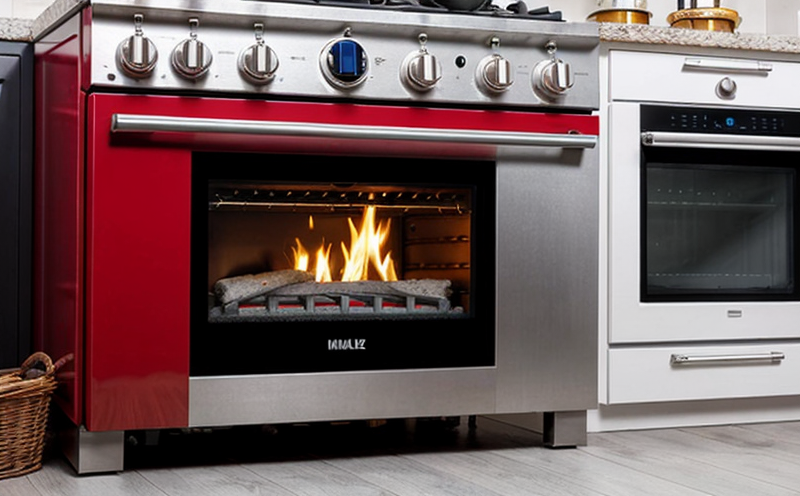Smoke Density Measurement for Household Appliances
The measurement of smoke density in household appliances is a critical aspect of ensuring product safety and compliance with international standards. As quality managers and compliance officers, you must be aware that the performance of certain household appliances during fire events directly impacts public safety. The accurate measurement of smoke density helps to identify potential hazards early on, allowing for necessary corrective actions before products reach consumers.
Smoke density refers to the concentration of particles suspended in a gas phase within a given volume of air. In the context of household appliances, it is essential to measure this parameter because excessive smoke can impair visibility and contribute to respiratory issues. International standards such as ISO 9248-3:2016 provide methodologies for determining smoke density based on light absorption techniques.
For instance, when testing refrigerators or air conditioners that are exposed to fire scenarios, the smoke generated by these appliances must meet specific limits set forth in relevant international standards. The test involves placing a specimen under controlled conditions where it is subjected to flames, and then measuring how much visible smoke is produced over time.
Accurate measurement tools like nephelometers or laser scattering spectrometers play crucial roles here. These devices capture light scattered by particles present in the smoke plume, providing precise data about its density. This information helps manufacturers understand their product's behavior during fires and make improvements where needed.
The testing process itself requires careful preparation of samples and adherence to strict protocols outlined in standards like ISO 9248-3:2016. Specimens are typically placed inside a specially designed chamber that simulates real-world fire conditions while allowing for continuous observation and measurement.
By focusing on smoke density, manufacturers can ensure their products adhere not only to local regulations but also international best practices, enhancing overall product safety and reliability.
Why It Matters
The importance of smoke density measurements cannot be overstated for household appliance manufacturers. Proper testing ensures that your products do not pose unreasonable risks to consumers in case they encounter fire hazards either at home or during transport.
Smoke produced by faulty appliances can obscure escape routes, leading to injuries or fatalities if occupants are unable to evacuate safely. By accurately measuring smoke density according to international standards, you demonstrate a commitment to protecting public health and safety.
In addition to enhancing user safety, demonstrating robust testing protocols also bolsters your brand reputation. Customers increasingly seek out brands that prioritize quality over cost-cutting measures, especially in sectors where product failures could have severe consequences.
Compliance with relevant standards like ISO 9248-3:2016 not only avoids potential legal issues but also opens doors to new markets that require stringent safety certifications. It shows buyers that you adhere to global best practices, which is particularly valuable when expanding internationally.
To sum up, thorough smoke density testing contributes significantly to both your business success and societal well-being by minimizing risks associated with household appliances.
International Acceptance and Recognition
The measurement of smoke density for household appliances is widely recognized across the globe due to its significance in ensuring product safety. International standards such as ISO 9248-3:2016 have been adopted by numerous countries around the world, reflecting their commitment to protecting consumers from fire-related hazards.
These standards outline rigorous procedures for testing various types of household appliances under controlled conditions that mimic actual fire scenarios. The results obtained through these tests provide valuable insights into how different products perform when exposed to flames and subsequent smoke generation.
The acceptance of these international norms ensures consistency in test methods and outcomes, facilitating easier trade between participating nations. Manufacturers who comply with such standards enjoy greater market access opportunities while maintaining high safety standards for their customers globally.
Moreover, adherence to recognized international practices fosters trust among stakeholders—be it regulators, insurers, or consumers alike. It reinforces the idea that manufacturers are committed not only to meeting minimum legal requirements but also exceeding expectations in terms of product quality and reliability.
Competitive Advantage and Market Impact
In today's competitive market, demonstrating a strong commitment to safety through rigorous smoke density testing can give your company a significant edge over competitors. Compliance with international standards like ISO 9248-3:2016 not only enhances product quality but also sets you apart as a leader in safeguarding public health and safety.
Consumers are becoming more aware of the importance of fire safety, especially when it comes to household appliances that can be found in close proximity to people. By prioritizing smoke density testing, you signal your dedication to producing safe products that meet or exceed regulatory requirements. This proactive approach builds consumer confidence and loyalty.
From a competitive standpoint, adhering to these stringent standards positions your brand as trustworthy and reliable. Potential customers are more likely to choose products from companies known for their commitment to safety and innovation. Furthermore, participating in international trade shows where compliance with such standards is emphasized can further enhance your company’s reputation and attract new business opportunities.
In addition to gaining competitive advantages domestically, focusing on smoke density testing allows you to expand into foreign markets that may have even stricter regulations regarding fire safety. By meeting these higher standards ahead of time, you avoid last-minute adjustments and associated costs, thereby streamlining entry into new territories.
Overall, prioritizing smoke density measurement in your household appliance designs not only enhances product quality but also opens doors to international markets while fostering trust among consumers worldwide.





